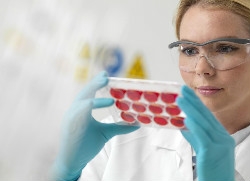(单词翻译:单击)
听力文本
From VOA Learning English, this is the Health Report.
American scientists have for the first time taken stem cells from human embryos that are genetic copies of living people. The goal is to create better treatments for disease. But the work has rasied ethical concerns about making genetic copies or cloning.
Cloning a human being is illegal in more than twelve states. Most scientists have rejected it, but some medical researchers are performing what is called "therapeutic cloning" to try to fight disease. Still, that method is banned in seven states.
One state where "therapeutic cloning" is not banned is Oregon, that is where researchers at Oregon Health & Science University in Portland were able to put human DNA into modified human eggs. They produced embryos that were genetically the same as the people who had donated their DNA. The researchers then took stem cells from the embryos, these cells are called "master cells". Scientists know how to use chemicals to cause master cells to develop into any tissue in the body.
The idea is that doctors could use tissue created this way to replaced diseased organs. The new body tissue would be a genetically match of the person receiving it, and there would be no danger that the patient's body would reject the new tissue which can happen with normal transplants.
Shoukhrat Mitalipov led the organ study, which involved more than twenty researchers. The scientists believed the stem cells could give doctors a new way to treat Parkinson's disease - a degenerative movement disorder. Scientists believe they could use this genetic material or DNA from a skin cell of someone with Parkinson's disease to create a personalized treatment.
Alta Charo is a bioethicist at the University of Wisconsin Law School, she believes it is too soon to say, whether the use of embryonic stem cells for personalized medicine would become common. Scientists could in fact find other less controversial sources of stem cells, however, she supports the use of stem cells to treat disease.
"I think that would argue for using them, I think there are moral obligation to people who are here among us, who are sick and in need. Trans-political concerns, and a public relations, and perception problems around the very earliest first two or three days worth of development of an embryo-like entity."
The research on the cloning of human embryos to harvest stem cells was published in the journal "Cell".
And that's the Health Report from VOA Learning English, I'm Mario Ritter.
文本为51VOA听写整理
译文属可可原创,仅供学习交流使用,未经许可请勿转载
词汇解释
1.embryo n. [胚] 胚胎;胚芽;初期
The sex of the embryo is predetermined at fertilization.
胚胎的性别早在受精时就决定了。
2.therapeutic adj. 治疗的;治疗学的;有益于健康的
They hustled Jeanne to accept their therapeutic plan.
他们强迫珍妮接受他们的治疗方案。
3.transplant n. 移植;移植器官;被移植物;移居者
She underwent a heart transplant in a last-ditch attempt to save her.
她动了心脏移植手术,这是为挽救她的生命而作的最后一次努力。
4.degenerative adj. 退化的;变质的;退步的
degenerative diseases such as arthritis
诸如关节炎之类的变性病
5.bioethicist n. 生物伦理学家
He also quoted National Institutes of Health bioethicist F.G. Miller, who argued in the Journal of Medical Ethics that ethical proscription against killing by doctors is “debatable.”
他同时还引用国家卫生研究院生物伦理学家F.G.米勒博士在《医学伦理学杂志》上发表的论文中的一句话:“这种用道德规范去衡量医生的行为并因此认定他们在杀人的做法,本身就可能是不道德的。”
参考译文
这里是美国之音慢速英语健康报道。
美国科学家首次从人类胚胎中提取干细胞,胚胎是活人的基因复制体。其目标是找到治疗疾病的更好方法,但这项工作引发人们对制造基因复制体或克隆的担忧。
复制人类在至少12个州都是非法的,许多科学家表示反对,但有的医疗研究者正在进行所谓的“治疗性克隆”,试图治愈疾病。不过有7个州都禁止该方法。
俄勒冈是不禁止“治疗性克隆”的一个州,在这里,波特兰奥勒冈州卫生科学大学的研究者们已将人类DNA放入修改后的人类卵子。他们制造出来的胚胎和捐赠DNA的人的基因一样,然后研究者从胚胎中取出干细胞,这些细胞被称为“万能细胞”。科学家知道如何使用化学品让万能细胞在人类的任何组织内发育。
研究者的设想是,医生可以用这种方法来将组织取代病变的器官,新的人体组织将和接受者的基因匹配,这样病人的身体就不会想一般的移植那样有排斥新组织的危险。
这项器官研究有20多名研究者参与,Shoukhrat Mitalipov是其负责人。科学家们认为,干细胞给了医生治疗老年痴呆症的新方法,这是一种退化性行动障碍。科学家认为可以使用老年痴呆症患者皮肤细胞内的基因材料或DNA来创造个性化的疗法。
Alta Charo是美国威斯康星大学法学院生物论理学家,她认为,断定使用胚胎细胞来进行个性化的治疗是否普及还为时过早。科学家可以找到其他不那么引起争议的干细胞来源,不过她支持使用干细胞来治疗疾病。
“我想应该支持使用,对于那些需要治疗的病人来说,我们有道义上的责任来帮助他们。以及围绕最初的两三天胚胎实体发育的跨政治的关注、公关活动和观念问题。”
有关克隆人类胚胎来获取干细胞的研究发表在杂志《细胞》上。
这里是美国之音慢速英语健康报道,我是马里奥·里特。


